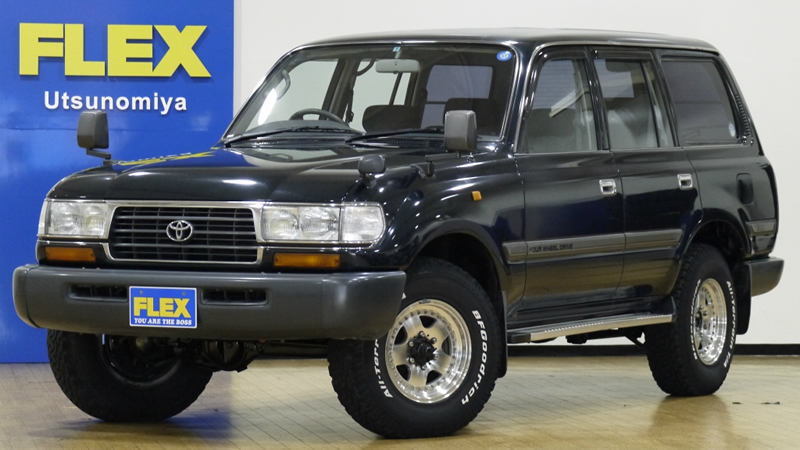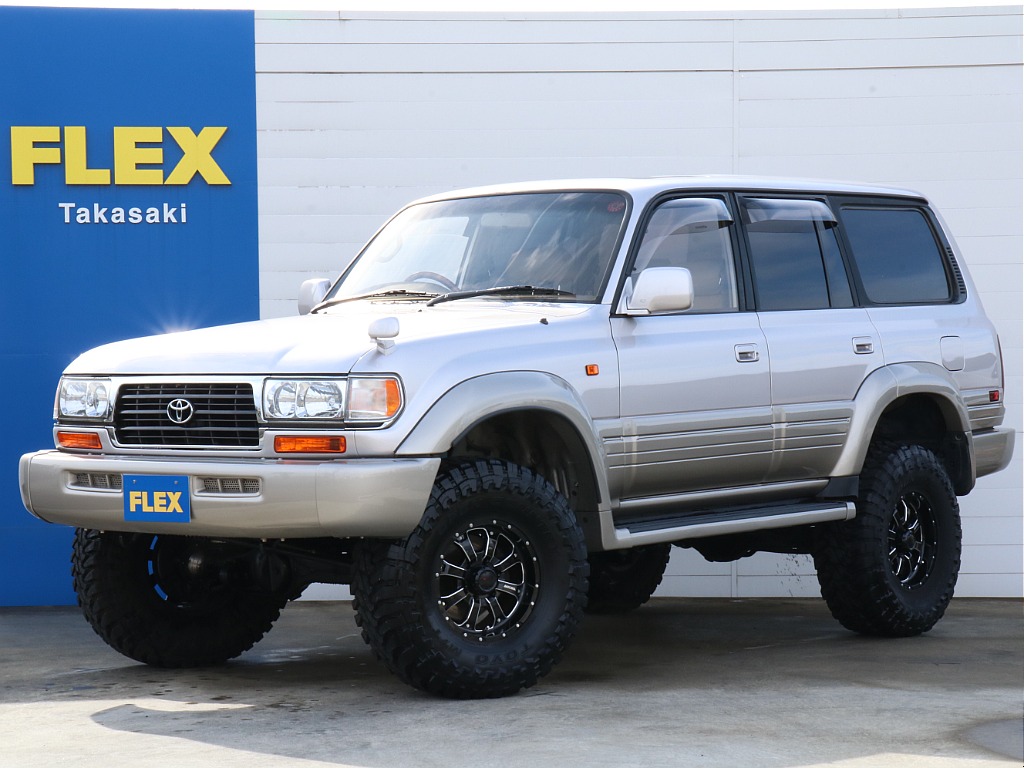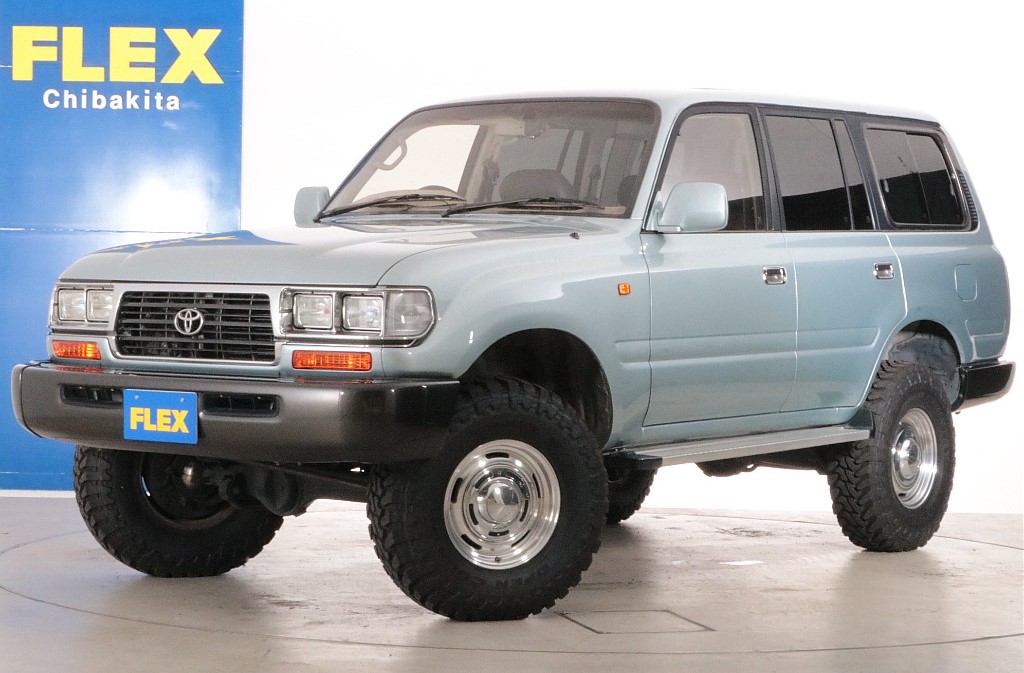Appeal of Toyota Land Cruiser 80 Diesel
Even today, the Land Cruiser 80 is still popular. Diesel cars are still in use in rural areas that do not have the vehicle emission regulations like urban areas. The Land Cruiser 80 was introduced in January 1990 and until the introduction of the Land Cruiser 100 in December 1997, approximately 547,400 Land Cruiser 80s were produced worldwide, of which about 107,000 were sold to drivers in Japan. Toyota produced around 406,700 units of its predecessor, the Land Cruiser 80, between August 1980 and December 1989, which led to an increase in the Land Cruiser 80’s popularity. At the end of the Land Cruiser 60 model’s run, there was a last-minute demand from fans who were worried that the next model would change from a 4WD style to a modern style, but when the Land Cruiser 80 was released, its popularity skyrocketed.
So what exactly is the appeal of the Land Cruiser 80? Why is it still attracting so many fans? It is a reasonably priced used car that is attractive, but there are many other points such as it is easy to drive; it is easy to customize, and the suspension is made for off-road driving. Here, we will explore the attractiveness of the Land Cruiser 80 diesel vehicle, which is the majority in the entire market, with a focus on its efficient engine.
A full-fledged 4WD Land Cruiser 80 from the heyday of diesel vehicles
The turbo diesel with its high fuel efficiency and toughness is suitable for a Land Cruiser
There were about 107,000 Land Cruiser 80s produced for the domestic market, most of which were diesel vehicles. The 1990s was a time when many 4WD vehicles were sold as more people wanted to explore the outdoors, and most of the fans who switched from ordinary passenger cars chose diesel vehicles with relatively high fuel consumption and low taxes.
The Mitsubishi Pajero, Isuzu Bighorn, and Nissan Safari/Terano shared the 4WD market with the Land Cruiser during this period, but the diesel engine models were the most popular. The reason seems to be that the manufacturers considered the number of sales and appealed mainly to diesel vehicle buyers. On the other hand, even if the fuel consumption and taxes were ignored, it was clear that some people decided that a diesel engine is more suitable for a large 4WD vehicle like the Land Cruiser.
This is evident from the fact that most large trucks, buses, and construction vehicles are diesel vehicles. Diesel engines are undoubtedly more fuel efficient than gasoline engines if the displacement is the same, but this is because a large proportion of the energy produced by burning fuel is converted into power.
This is expressed as “good thermal efficiency”, but due to the characteristics of fuel, diesel engines do not rely on spark plugs and burn by self-ignition at high temperatures, so the compression ratio is about twice that of gasoline engines. It’s a feature. By strongly compressing the air and injecting light oil into the high temperature, a large force is generated, and the high thermal efficiency results in improved fuel efficiency.
In addition, light oil is less volatile than gasoline and has a slower burning rate. Gasoline engines are better at instantaneous power and high-speed rotation, but light oil continues to burn in the cylinder for a long time, so the force that pushes the piston down produces a large amount of torque. A large torque is very convenient for moving a large car. Perhaps for that reason, the Land Cruiser 80 had a full lineup of diesel vehicles.
Land Cruiser 80 4.2-liter straight 6 diesel turbo and non-turbo
The Land Cruiser 80 diesel engine has three types that share the same cylinder block with the same displacement. The 4.2-liter in-line 6-cylinder non-turbo 1HZ model was installed in the base models STD and GX, and the 1HD-T model was installed in the upper models VX and VX Limited with direct injection turbo specification. Of these, the 1HD-T type evolved into the 1HD-FT type, which advanced exhaust gas measures in the latter half of the model.
It can be said that the 1HZ type, which is also installed in the former Land Cruiser 70 van for the domestic market, is the most diesel-like engine. Thanks to the abundant torque generated from idling, which is unique to non-turbo, it is a feature that stands out for its ease of handling while maintaining low-speed rotation. It is especially effective in off-road driving at extremely low speeds and in urban areas.
The 1HD-T type has a relatively fast combustion speed thanks to the direct injection turbo, so it generates more torque than the 1HZ type in a wide range of rotation. On the other hand, it can be said that the 1HD-T type is superior in terms of its wide range of coverage from off-road to the highway.
The 1HD-FT type is a diesel that has improved the emissions purification while improving the efficiency of intake and exhaust by changing the cylinder head of the 1HD-T type to 4 valves per cylinder (24 valves in total) and improving the power performance. Although the power and torque are better than the 1HD-T model, the main purpose of the improvement was to comply with emissions regulations, so the difference is not so noticeable, but driving it feels the same as driving the 1HD-T model. The most attractive part is it is practical.
Diesel engine installed in Land Cruiser 80
| Equipped vehicle | HZJ81V | HDJ81V | HDJ81V |
|---|---|---|---|
| Engine | 1HZ | 1HD-T | 1HD-FT |
| Displacement | 4,163cc | 4,163cc | 4,163cc |
| Combustion chamber | swirl chamber | direct injection | direct injection |
| Compression ratio | 22.4 | 18.6 | 18.6 |
| Supercharger | — | yes | yes |
| Valve mechanism | SOHC | SOHC | SOHC |
| No. of valves (per cylinder) | 2 | 2 | 4 |
| Maximum output | 135PS/133HP/4,000rpm | 165PS/162HP/3,600rpm | 170PS/167HP/3,600rpm |
| Maximum torque | 28.5kgm/206 lb.-ft./2,200rpm | 37.0kgm/267 lb.-ft./2,000rpm | 38.7kgm/279 lb.-ft./2,500rpm |
Land Cruiser 80’s full-time 4DW goes well with diesel engines
The Land Cruiser 80’s popularity isn’t just due to its powerful diesel engine; the large torque of a diesel engine is best demonstrated with a full-time 4WD. The Land Cruiser 80 was the first model to switch from a part-time 4WD system to a full-time 4WD system.
A part-time 4WD system that switches to 2WD on general roads and 4WD only when driving off-road tends to be unstable when driving on unpaved roads such as dirt or wet paved roads, and it can be nerve-wracking to drive. Although 2WD does not turn the front wheels, it leads to a slight eco-friendly driving, but a large 4WD like the Land Cruiser 80 can be driven stably and easily even on paved roads in 4WD. For example, when a strong wind hits a highway or when approaching a curve on a slippery road surface, the torque is distributed by the four tires gripping the road surface, skidding is less likely to occur, and the steering operation is stable.
In full-time 4WD, the propeller shafts and axle shafts are moved excessively, which creates friction loss, but because it is a powerful diesel engine, it does not worsen fuel consumption. The compatibility of a full-time 4WD and a diesel engine is excellent.




